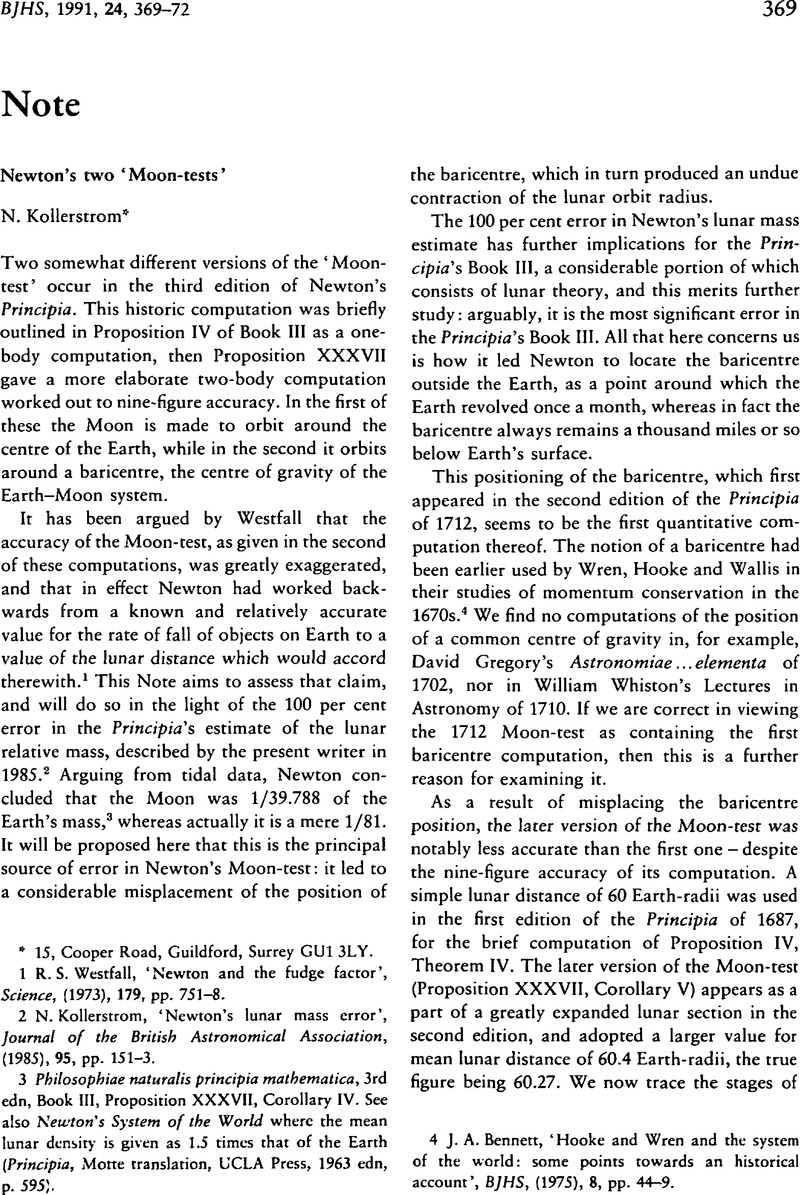No CrossRef data available.
Article contents
Newton's two ‘Moon-tests’
Published online by Cambridge University Press: 05 January 2009
Abstract

- Type
- Note
- Information
- The British Journal for the History of Science , Volume 24 , Issue 3 , September 1991 , pp. 369 - 372
- Copyright
- Copyright © British Society for the History of Science 1991
References
1 Westfall, R. S., ‘Newton and the fudge factor’, Science, (1973), 179, pp. 751z–8.CrossRefGoogle ScholarPubMed
2 Kollerstrom, N., ‘Newton's lunar mass error’, Journal of the British Astronomical Association, (1985), 95, pp. 151–3.Google Scholar
3 Philosophiae naturalis principia mathematica, 3rd edn, Book III, Proposition XXXVII, Corollary IV. See also Newton's System of the World where the mean lunar density is given as 1.5 times that of the Earth (Principia, Motte translation, UCLA Press, 1963 edn, p. 595).Google Scholar
4 Bennett, J. A., ‘Hooke and Wren and the system of the world: some points towards an historical account’, BJHS, (1975), 8, pp. 44–9.CrossRefGoogle Scholar
5 Picard, J., Traité du nivellement… avec une relation du quelques nivellements faits par ordre du roy et un abrégé de la mesure de la terre, Paris, 1684.Google Scholar
6 Whiteside, D. T., The Preliminary Manuscripts for Isaac Newton's 1687 Principia, Cambridge, 1989, p. xi.Google Scholar
7 Corollary IX of Proposition IV of Book I of the Principia: ‘The arc which a body, uniformly revolving in a circle with a given centripetal force, describes in any time, is a mean proportion between the diameter of the circle, and the space which the same body falling by the same force would describe in the same time’ (Motte's translation, Cajori edition, I, p. 46).
8 Brougham, H. P. and Routh, E. J., Analytical View of Sir Isaac Newton's Principia, 1855, p. 40.Google Scholar
9 Roche, J., ‘Newton's Principia’, in Let Newton be!. (ed. Fauvel, J. et al. ), Oxford, 1988, p. 56.Google Scholar
10 Westfall, , op. cit. (1), p. 752.Google Scholar
11 Westfall, R. S., Never at Rest, Cambridge, 1980, p. 151.Google Scholar
12 Truesdall, C., ‘A programme towards rediscovering the rational mechanics of the Age of Reason’, Archives for History of Exact Sciences, (1960), 1, p. 23.Google Scholar
13 Cohen, I. Bernard, ‘Newton's Second Law and the concept of force in the Principia’, Texas Quarterly Journal, (1967), 10, p. 128.Google Scholar
14 Cohen, I. Bernard, Introduction to Newton's Principia, Cambridge Mass., 1971, p. 66.CrossRefGoogle Scholar
15 Westfall, , op. cit. (1), pp. 751–8.Google Scholar
16 Westfall, , op. cit. (1), p. 735.Google Scholar
17 Whisron, W., Astronomical Lectures, 1710, Frontispiece.Google Scholar
18 Nelkon, M. and Parker, P., Advanced-Level Physics, London, 1981, p. 44.Google Scholar


